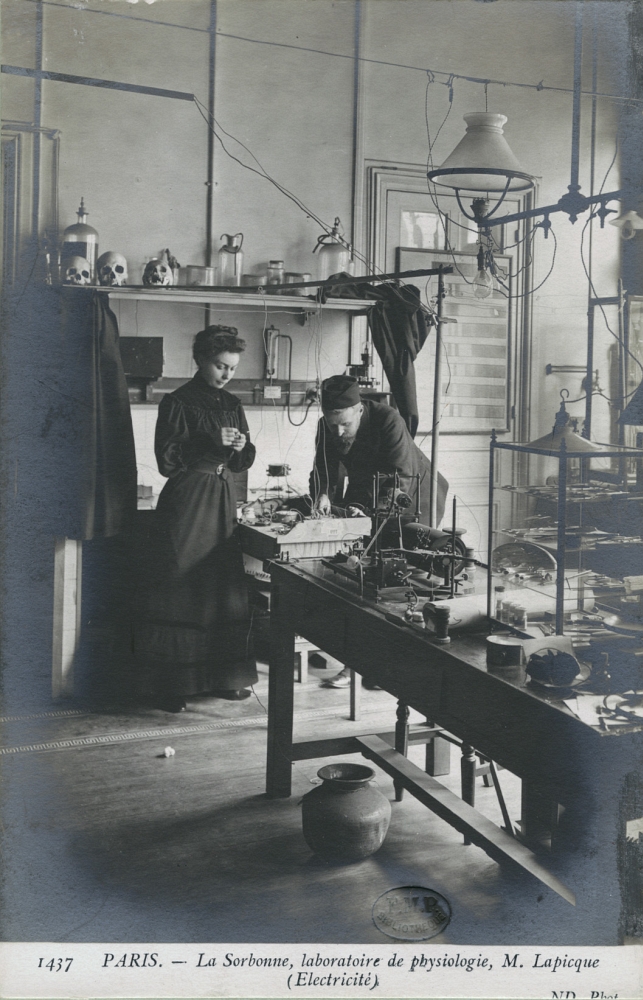Louis Lapicque on:
[Wikipedia]
[Google]
[Amazon]
 Louis Édouard Lapicque (1 August 1866 – 6 December 1952) was a French
Louis Édouard Lapicque (1 August 1866 – 6 December 1952) was a French 
Guide to the Louis Lapicque PapersLouis Lapicque Papers in UTHSCSA Digital Archives
* {{DEFAULTSORT:Lapique, Louis 1866 births French Freemasons 1952 deaths People from Épinal French neuroscientists French physiologists Members of the French Academy of Sciences
 Louis Édouard Lapicque (1 August 1866 – 6 December 1952) was a French
Louis Édouard Lapicque (1 August 1866 – 6 December 1952) was a French neuroscientist
A neuroscientist (or neurobiologist) is a scientist who has specialised knowledge in neuroscience, a branch of biology that deals with the physiology, biochemistry, psychology, anatomy and molecular biology of neurons, Biological neural network, n ...
, socialist
Socialism is a left-wing economic philosophy and movement encompassing a range of economic systems characterized by the dominance of social ownership of the means of production as opposed to private ownership. As a term, it describes the e ...
activist, antiboulangist, dreyfusard and freemason
Freemasonry or Masonry refers to fraternal organisations that trace their origins to the local guilds of stonemasons that, from the end of the 13th century, regulated the qualifications of stonemasons and their interaction with authorities ...
who was very influential in the early 20th century. One of his main contributions was to propose the integrate-and-fire
Biological neuron models, also known as a spiking neuron models, are mathematical descriptions of the properties of certain cells in the nervous system that generate sharp electrical potentials across their cell membrane, roughly one millisecon ...
model of the neuron in a seminal article published in 1907. Today, this model of the neuron is still one of the most popular models in computational neuroscience
Computational neuroscience (also known as theoretical neuroscience or mathematical neuroscience) is a branch of neuroscience which employs mathematical models, computer simulations, theoretical analysis and abstractions of the brain to u ...
for both cellular and neural networks
A neural network is a network or circuit of biological neurons, or, in a modern sense, an artificial neural network, composed of artificial neurons or nodes. Thus, a neural network is either a biological neural network, made up of biological ...
studies, as well as in mathematical neuroscience
Computational neuroscience (also known as theoretical neuroscience or mathematical neuroscience) is a branch of neuroscience which employs mathematical models, computer simulations, theoretical analysis and abstractions of the brain to u ...
because of its simplicity. A review article was published for the centenary of the original Lapicque's 1907 paper - this review also contains an English translation of the original paper.
His wife, Marcelle Lapicque
Marcelle de Heredia Lapicque (1873 – 1960) was a French Neurophysiology, neurophysiologist known for her research on nerve impulses (chronaxie) and the effects of poisons, especially strychnine, on chronaxie. She was in charge of the Laboratoire ...
, was also a neurophysiologist. Louis Lapicque "insisted on the importance of his wife as equal co-worker in all his research"..

Works
* Notice on titles and scientific works of Louis Lapicque (1908) * Excitability function of time, chronaxie, its meaning and its measure (1926) * Nervous machine (1943) * Neuromuscular isochronism and rythmogenic excitability (1947) * On reaction times according to races and social conditions (1901) * Quantitative research on nervous electrical excitation treated like a polarization (1907) * Consciousness as a cellular function (1952)See also
* ChronaxieReferences
External links
Guide to the Louis Lapicque Papers
* {{DEFAULTSORT:Lapique, Louis 1866 births French Freemasons 1952 deaths People from Épinal French neuroscientists French physiologists Members of the French Academy of Sciences